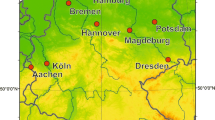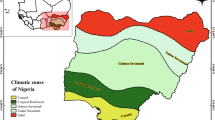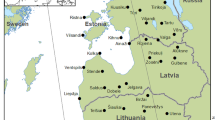Abstract
Heat waves are one of the main concerns related to the impacts of climate change, because their frequency and severity are projected to increase in a future climate. The objectives of this work are to study the long-term variability of heat waves over Argentina and to estimate recurrence probability of the most severe 2008 heat wave in Buenos Aires. We used three definitions of heat waves that were based on (1) daily maximum temperature above the 90th percentile (MaxTHW), (2) daily minimum temperature above the 90th percentile (MinTHW) and (3) both maximum and minimum temperatures above the corresponding 90th percentiles (EHW). The minimum length of a heat wave was 3 days, and the analysis was performed over the October–March period. Decadal values in Buenos Aires experienced clear increases in heat waves according to MinTHW and EHW, with the highest frequency for both in the 2001–2010 decade, but at other stations, combinations of different trends and decadal variability resulted in some cases in a decrease of extreme heat waves. In the north-western part of the country, a strong positive change in the last decade was found, mainly due to the increment in the persistence of MinTHW but also accompanied by increases in MaxTHW. In general, other stations show a clear positive trend in MinTHW and decadal variability in MaxTHW, with the largest EHW cases in the last decade. We also estimated recurrence probability of the longest and most severe heat wave in Buenos Aires (over 1909–2010, according to intensity measured by the cumulative excess of maximum daily temperature above the 90th percentile) that occurred from 3 to 14 November 2008, by means of simulations with a stochastic first-order autoregressive model. The recurrence probability of such long and severe heat wave is small in the present climate but it is likely to increase substantially in the near future even under a moderate warming trend.








Similar content being viewed by others
References
Alessandro AP, de Garín AB (2003) A study on predictability of human physiological strain in Buenos Aires City. Meteorol Appl 10:263–271. doi:10.1017/S1350482703003062
Alexander L, Zhang X, Peterson TC, Caesar J, Gleason B, Klein Tank A, Haylock M, Collins D, Trewin B, Rahimzadeh F, Tagipour A, Ambenje P, Rupa Kumar K, Revadekar J, Griffiths G, Vincent L, Stephenson D, Burn J, Aguilar E, Brunet M, Taylor M, New M, Zhai P, Rusticucci M, Vazquez-Aguirre JL (2006) Global observed changes in daily climate extremes of temperature and precipitation. J Geophys Res 111, D05109
Barriopedro D, Fischer EM, Luterbacher J et al (2011) The hot summer of 2010: redrawing the temperature record map of Europe. Science 332:220–224. doi:10.1126/science.1201224
Beniston M, Stephenson DB, Christensen OB et al (2007) Future extreme events in European climate: an exploration of regional climate model projections. Clim Change 81:71–95. doi:10.1007/s10584-006-9226-z
Campetella C, Rusticucci M (1998) Synoptic analysis of an extreme heat wave over Argentina in March 1980. Meteorol Appl 5:217–226
Carvalho LMV, Jones C, Liebmann B (2004) The South Atlantic convergence zone: intensity, form, persistence, and relationships with intraseasonal to interannual activity and extreme rainfall. J Clim 17:88–108
Cerne SB, Vera CS (2011) Influence of the intraseasonal variability on heat waves in subtropical South America. Clim Dyn 36:2265–2277. doi:10.1007/s00382-010-0812-4
Colombo AF, Etkin D, Karney BW (1999) Climate variability and the frequency of extreme temperature events for nine sites across Canada: implications for power usage. J Clim 12:2490–2502
De Bono A, Giuliani G, Kluser S, Peduzzi P (2004) Impacts of summer 2003 heat wave in Europe. UNEP/DEWA/GRID-Europe Environ Alert Bull 2:1–4
Donat M, Alexander L, Yang H et al (2013) Updated analyses of temperature and precipitation extreme indices since the beginning of the twentieth century: the HadEX2 dataset. J Geophys Res 118:2098–2118. doi:10.1002/jgrd.50150
Field C, Barros V et al (2013) Summary for Policymakers. In: Climate Change 2013: The Physical Science Basis. Contribution of Working Group I to the Fifth Assessment Report of the Intergovernmental Panel on Climate Change, Cambridge University Press, Cambridge, United Kingdom and New York, NY, USA
Hartmann DL, Klein Tank AMG, Rusticucci M et al (2013) Observations: Atmosphere and Surface. In: Climate Change 2013: The Physical Science Basis. Contribution of Working Group I to the Fifth Assessment Report of the Intergovernmental Panel on Climate Change, Cambridge University Press, Cambridge, United Kingdom and New York, NY, USA
IPCC (2013) Annex I: Atlas of Global and Regional Climate Projections. In: Climate Change 2013: The Physical Science Basis. Contribution of Working Group I to the Fifth Assessment Report of the Intergovernmental Panel on Climate Change, Cambridge University Press, Cambridge, United Kingdom and New York, NY, USA
Kirtman B, Power SB, Adedoyin JA et al (2013) Near-term Climate Change: Projections and Predictability. In: Climate Change 2013: The Physical Science Basis. Contribution of Working Group I to the Fifth Assessment Report of the Intergovernmental Panel on Climate Change. Cambridge University Press, Cambridge, United Kingdom and New York, NY, USA
Kyselý J (2010) Recent severe heat waves in central Europe: how to view them in a long-term prospect? Int J Climatol 30:89–109. doi:10.1002/joc.1874
Kyselý J, Kim J (2009) Mortality during heat waves in South Korea, 1991 to 2005: how exceptional was the 1994 heat wave? Climate Res 38(2):105–116
Macchiato M, Serio C, Lapenna V, LaRotonda L (1993) Parametric time series analysis of cold and hot spells in daily temperature: an application in southern Italy. J Appl Meteorol 32:1270–1281
Mearns LO, Katz RW, Schneider SH (1984) Extreme high temperature events: changes in their probabilities with changes in mean temperature. J Clim Appl Meteor 23:1601–1608
Penalba OC, Rivera JA, Pántano VC (2014) The CLARIS LPB database: constructing a long-term daily hydro-meteorological dataset for La Plata Basin, Southern South America. Geosci Data J. doi:10.1002/gdj3.7
Robine J-M, Cheung SLK, Le Roy S et al (2008) Death toll exceeded 70,000 in Europe during the summer of 2003. C R Biol 331:171–178. doi:10.1016/j.crvi.2007.12.001
Rusticucci M (2012) Observed and simulated variability of extreme temperature events over South America. Atmos Res 106:1–17. doi:10.1016/j.atmosres.2011.11.001
Rusticucci M, Barrucand M (2004) Observed trends and changes in temperature extremes over Argentina. J Clim 17:4099–4107
Rusticucci M, Vargas W (1995) Synoptic situations related to spells of extreme temperatures over Argentina. Meteorol Appl 2:291–300
Rusticucci M, Vargas W (2001) Interannual variability of temperature spells over Argentina. Atmosfera 14:75–86
Acknowledgments
The study was supported by a joint project funded by the Ministerio de Ciencia, Tecnología e Innovación Productiva of Argentina (ARC/14/25) and the Czech Ministry of Education (7AMB15AR001), and by the UBA20020130100263BA and CONICET PIP0227 projects. The data were provided by the National Weather Service of Argentina.
Author information
Authors and Affiliations
Corresponding author
Rights and permissions
About this article
Cite this article
Rusticucci, M., Kyselý, J., Almeira, G. et al. Long-term variability of heat waves in Argentina and recurrence probability of the severe 2008 heat wave in Buenos Aires. Theor Appl Climatol 124, 679–689 (2016). https://doi.org/10.1007/s00704-015-1445-7
Received:
Accepted:
Published:
Issue Date:
DOI: https://doi.org/10.1007/s00704-015-1445-7




